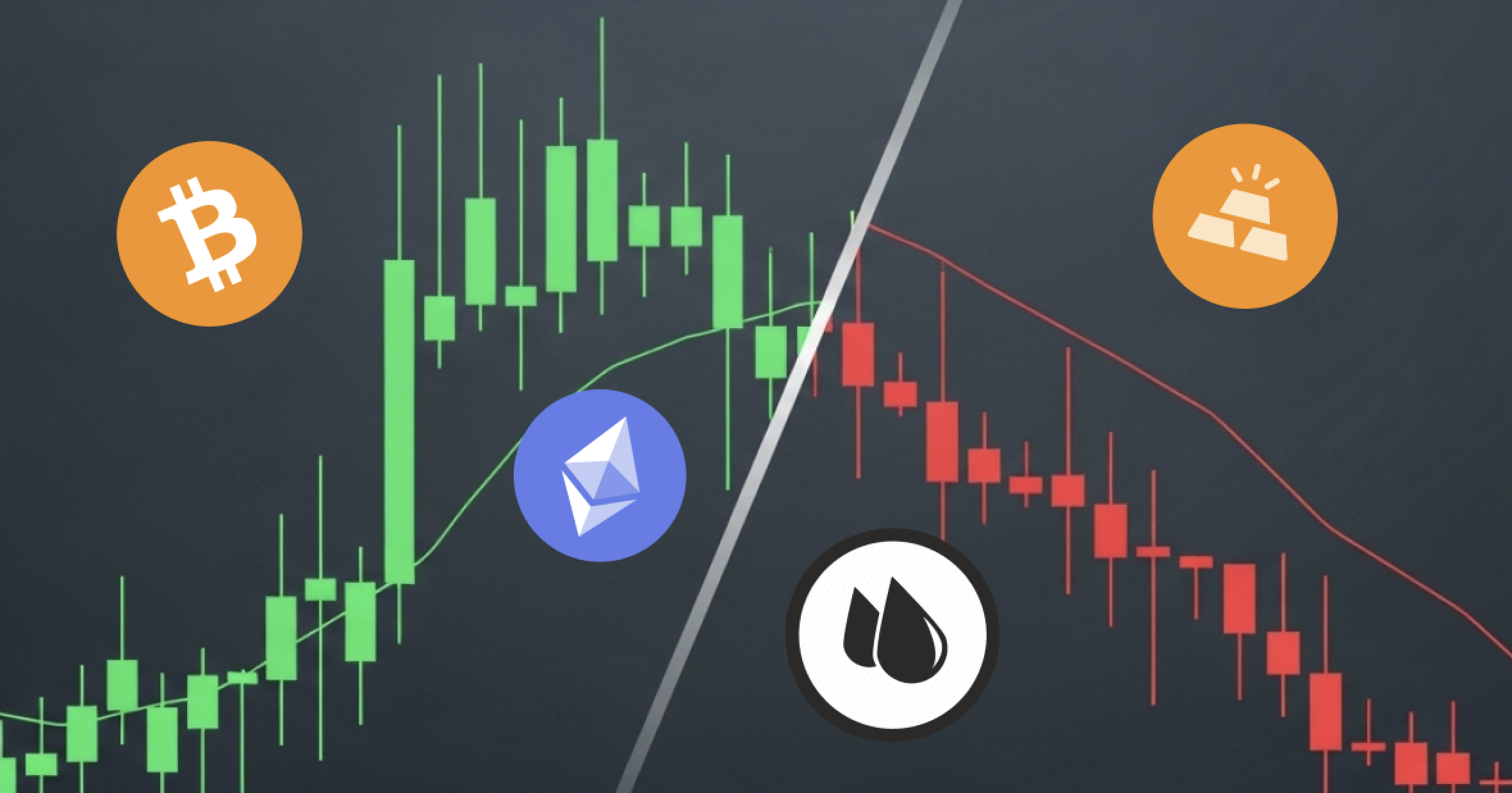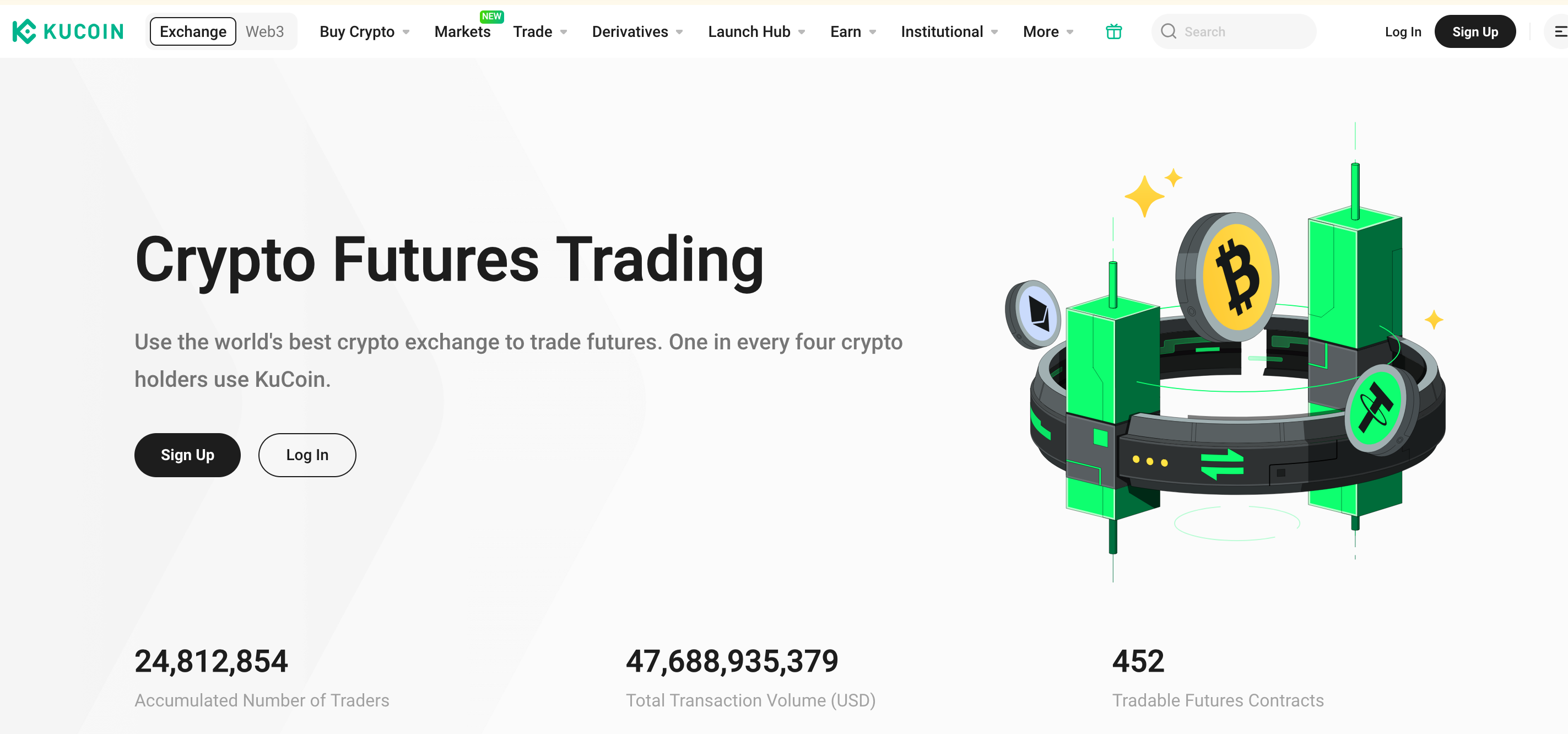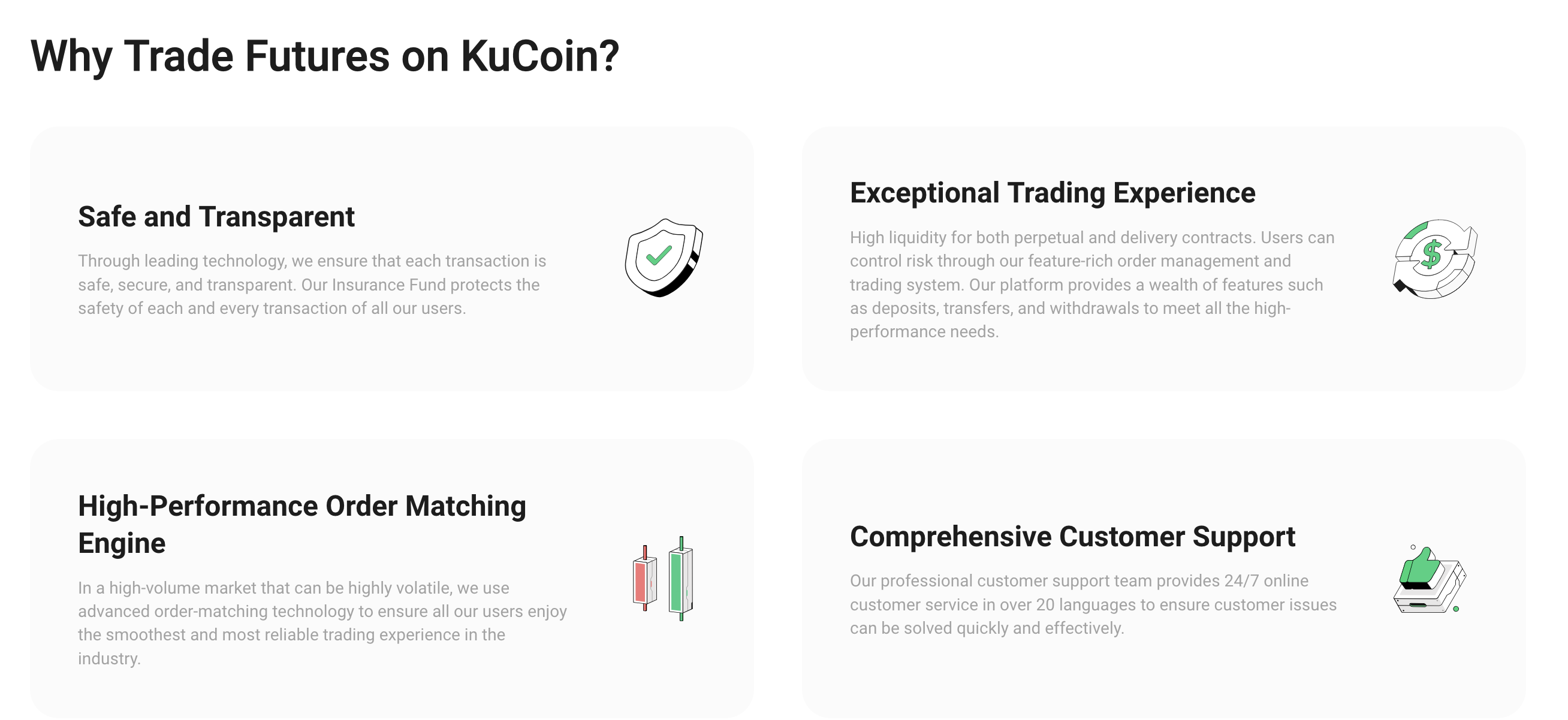
In the vast and dynamic cryptocurrency market, Bitcoin (BTC) futures trading is increasingly becoming a hot area for investors seeking profit. It not only offers opportunities to profit when the market rises but also allows for gains through "short-selling" mechanisms when prices fall, with the use of leverage further amplifying potential returns. However, high returns often come with high risks, and for newcomers to this field, a deep understanding of its mechanisms is crucial before diving in. This guide aims to provide a clear, comprehensive quick start guide to BTC futures trading for beginners, helping you grasp core concepts and guiding you on how to begin your trading journey on a leading and user-friendly platform like KuCoin.
1.What is BTC Futures Trading? Understanding Digital Asset Derivatives
BTC futures trading, as its name suggests, is not about directly buying and selling Bitcoin itself. Instead, it's a standardized contract about the future price of Bitcoin. This contract specifies that a certain amount of Bitcoin will be bought or sold at a predetermined price on a specific future date. It allows traders to "bet" on or "hedge" against the future price movement of BTC without actually holding these crypto assets.
1.1 The Nature of Futures: Contract vs. Spot Differences
The core of futures trading lies in its "contract" nature. You are trading a certificate representing future rights and obligations, not a physical asset. This contract is highly standardized, with its trading units, delivery dates, minimum price increments, etc., all uniformly set by the exchange. This differs fundamentally from directly buying Bitcoin in the spot market where you "exchange money for goods" immediately:
-
Spot Trading: You immediately own Bitcoin. The risk lies in the price fluctuations of the coin, but there's no liquidation risk.
-
Futures Trading: You don't own Bitcoin, but participate in price movements through a contract. You can use leverage, but face the risk of liquidation.
1.2 Dated Futures vs. Perpetual Futures: Beginners Should Focus on Perpetual Contracts
In BTC futures trading, you will primarily encounter two types of contracts:
-
Dated Futures (Delivery Futures): These contracts have a clear expiration date (e.g., BTCUSDT 20250926, meaning a Bitcoin contract expiring in September 2025). At expiration, the contract is automatically settled (usually cash-settled, where profits and losses are cleared to your account), without actual Bitcoin delivery.
-
Perpetual Futures (Perpetual Swaps): This is the most popular and liquid type in the crypto futures market, especially suitable for active traders and beginners. Unlike dated futures, perpetual contracts have no expiration date, allowing you to hold positions indefinitely. To keep the price of perpetual contracts as close as possible to the spot price of Bitcoin, they introduce a unique "funding rate" mechanism, which we will explain in detail later.
The advantages of perpetual contracts include: No need to worry about contract expiration, a trading experience closer to spot trading, and typically much higher liquidity than dated futures.
2.Essential Concepts You Must Know: The Language of BTC Futures Tradin
To enter the world of BTC futures trading, you need to master some core terms. Understanding them is fundamental to effective risk management and trading decisions.
-
Leverage: This is the appeal and also the source of risk in futures trading. Leverage allows you to control a large amount of capital with a relatively small portion of your own money. For example, with 10x leverage, your $100 in margin can control $1,000 worth of Bitcoin contracts. While it can significantly amplify profits, it will equally amplify losses. Beginners must start with low leverage (e.g., 2x-5x).
-
Margin: The capital you deposit to open and maintain a leveraged position. It acts as collateral for your trade. It is divided into:
-
Initial Margin: The minimum funds required to open a position.
-
Maintenance Margin: The minimum equity required to keep a position open without being forced liquidated. When your account equity falls below this level, you face liquidation risk.
-
-
Long: You open a position (buy) with the expectation that the price of Bitcoin will increase. If the price rises, you profit.
-
Short: You open a position (sell) with the expectation that the price of Bitcoin will decrease. If the price falls, you profit.
-
Liquidation: This is the worst nightmare in futures trading. When your floating losses cause your margin to be insufficient to cover the maintenance margin, the exchange will force-close your position to avoid its own risk. This means you will lose all the margin you put in. Understanding and avoiding liquidation is the top priority in futures trading.
-
Funding Rate (for Perpetual Contracts): This is a unique mechanism for perpetual contracts. To keep the perpetual contract price close to the spot price, longs and shorts periodically (usually every 8 hours) exchange fees. If the rate is positive (perpetual price is higher than spot), longs pay shorts; if negative (perpetual price is lower than spot), shorts pay longs. It affects your holding cost or income.
-
USDT-Settled Linear Contracts: These contracts use USDT as the margin and profit/loss settlement currency.
-
Advantages: P&L calculation is intuitive because profits and losses are calculated in stable USDT, allowing you to clearly see how much USD you've gained or lost; your margin value does not fluctuate with Bitcoin's price volatility, making risk management more stable. This makes it the most recommended contract type for beginners.
-
Contrast with Coin-Margined Contracts: In coin-margined contracts, you use BTC as margin, and P&L is also calculated in BTC. When BTC's price falls, your margin also depreciates, accelerating the risk of liquidation, and P&L calculation is more complex.
-
KuCoin Futures platform provides clear liquidation price alerts, real-time funding rate displays, and other features designed to help users better understand and manage these risks.
3.Getting Started with BTC Futures Trading on KuCoin: Practical Steps

KuCoin, as one of the world's leading cryptocurrency exchanges, is an ideal choice for many traders engaging in BTC futures trading due to its rich product offerings, user-friendly interface, and robust security. Here are the simple steps to start your futures trading journey on KuCoin:
3.1 Step 1: Create Your KuCoin Account and Complete KYC
Before you can start trading any crypto asset, including BTC futures, having a legitimate account is essential.
-
Visit the KuCoin Official Website and click the registration button.
-
Please ensure you complete the "Know Your Customer" (KYC) verification process. This is a common requirement for regulated exchanges worldwide, aiming to ensure trading security and compliance, while also increasing your trading limits and withdrawal permissions.
3.2 Step 2: Deposit and Transfer Funds to Your Futures Account
After setting up your account and completing KYC, you'll need to fund your trading account:
-
First, deposit your USDT (or other cryptocurrencies that you can convert to USDT) into your KuCoin "Main Account."
-
Then, you need to transfer USDT from your "Main Account" to your "Futures Account." This step is crucial as it helps you segregate your spot and futures trading funds for better risk management.
-
For detailed instructions on depositing funds and transferring assets, you can refer to the relevant guides in the KuCoin Help Center. https://www.kucoin.com/support
3.3 Step 3: Familiarize Yourself with the Futures Trading Interface
Log in to your KuCoin account, navigate to the "Derivatives" section, and then select "Futures Trading" to enter the futures trading interface.
-
Candlestick Chart and Depth Chart: These are core for market analysis, showing price trends, trading volume, and the distribution of buy and sell orders.
-
Order Book: Displays real-time buy and sell limit orders, reflecting market liquidity.
-
Order Entry Panel: Where you input your trading instructions (buy/sell, quantity, price, leverage, etc.).
-
Positions Tab: Shows your current position information, floating profit/loss, liquidation price, and more.
-
Familiarizing yourself with the functions of these areas will help you trade more effectively. KuCoin's interface is intuitively designed, allowing even beginners to quickly get started. It's recommended that beginners take time to explore the KuCoin Futures Trading Tutorial for more details.
3.4 Step 4: Place Your First Trade (Proceed with Caution)
As a beginner, remember: starting with small capital and extremely low leverage is your most important rule for survival.
-
Select Contract: On the top left of the trading interface, select the "BTC/USDT Perpetual" contract.
-
Choose Order Type:
-
Limit Order: You specify a price to buy or sell at. The order will execute when that price is reached, suitable for users who want to trade at a specific price. Recommended for beginners as it offers better control over entry points.
-
Market Order: Executes immediately at the best available market price, suitable for speed, but may incur slippage leading to unfavorable execution prices.
-
Stop-Loss Market/Limit Order: This is a crucial risk management tool. When the price reaches a stop-loss level, it automatically triggers a market or limit order to close the position and limit losses. It is highly recommended to set this simultaneously when opening a position.
-
-
Set Leverage: Adjust the leverage in the order entry panel. Be sure to choose very low leverage, such as 2x or 3x. High leverage means even small price fluctuations can lead to liquidation.
-
Enter Amount: Input the number of contracts or the USDT value you wish to trade.
-
Choose Direction: Based on your market analysis, click "Buy/Long" if you expect BTC to rise, or "Sell/Short" if you expect it to fall.
-
Confirm Order: Carefully review all parameters before confirming.
Ready to place your first trade? Start your BTC Futures journey on KuCoin Futures Platform now!

4.Essential Risk Management Tips for Beginners: Surviving in the BTC Futures Market
The appeal of Bitcoin futures trading lies in leverage, and its risks also stem from leverage. For beginners, the following risk management strategies are more important than any trading strategy; they are your foundation for survival and growth in the market:
-
Always Use Low Leverage and Control Position Size: This cannot be overstressed. Never invest more than you can afford to lose. For beginners, it's recommended that a single position does not exceed 5% of your total capital, and leverage does not exceed 5x. Small position sizes and low leverage mean you have more room for error, and even if your judgment is wrong, you won't be wiped out in one go.
-
Setting Stop-Loss Orders is Your Lifeline: Always set a stop-loss order when opening a position. A stop-loss is your maximum acceptable loss limit. When the market moves against your expectation, the stop-loss order will automatically close your position, preventing losses from escalating indefinitely. Don't harbor false hope that the price will rebound. Stop-loss orders are non-negotiable for protecting your capital.
-
Do Not Overtrade: Frequent opening and closing of positions, especially without a clear trading logic, will only increase trading costs and slippage, and amplify the risk of emotional decision-making. Develop a trading plan and patiently wait for signals that align with your plan.
-
Be Aware of Your Liquidation Price: Continuously monitor the liquidation price of your position. When the market price approaches your liquidation price, consider cutting your losses promptly or adding more margin (though the latter is generally not recommended for beginners, as it might mean throwing good money after bad).
-
Maintain Emotional Discipline: Greed and fear are the biggest enemies in futures trading. During market volatility, it's easy to get caught up in chasing pumps and selling into dumps. Stick to your trading plan and don't be swayed by short-term market noise.
-
Continuous Learning and Demo Trading: The market changes rapidly, and knowledge is power. Continuously learn new analysis methods and risk management techniques. Most importantly, utilize the demo trading functionprovided by exchanges (e.g., KuCoin Futures Demo Trading) to practice without real funds, master operations, test strategies, and gain experience.
KuCoin platform provides various risk management tools, including stop-loss/take-profit settings and liquidation alerts, and boasts a comprehensive KuCoin Learn section and a demo trading system, making it an ideal place for you to learn and practice.
5.Conclusion: Embarking on Your Bitcoin Futures Journey

Bitcoin futures trading undoubtedly offers exciting opportunities for crypto investors, but its complexity and inherent risks cannot be ignored. For beginners looking to venture into this field, a solid knowledge base, a deep understanding of key concepts, and most importantly, strict risk management discipline, will be crucial for establishing a foothold in this vibrant market.
From understanding the advantages of USDT-settled linear contracts, to mastering the principles of leverage and liquidation, and developing the good habit of setting stop-losses, every step is vital. Choosing a secure, transparent, and resource-rich trading platform like KuCoin can provide a solid foundation for your futures trading journey.
We encourage you to responsibly explore the infinite possibilities of BTC futures trading after thoroughly educating yourself and understanding the risks involved. Visit the KuCoin Futures Platform now to begin your Bitcoin futures trading learning and practice journey!












